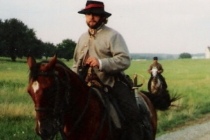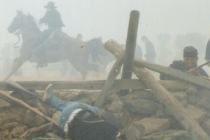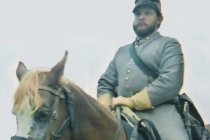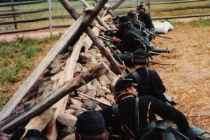Recent News
Our online presence has moved ...
- Details
 The Civil War Round Table of Western Missouri's website is no longer being updated due to staffing issues.
The Civil War Round Table of Western Missouri's website is no longer being updated due to staffing issues.
However, you can still follow us on our Facebook page at https://www.facebook.com/CWRTWM/.
The Sultana Disaster Museum
- Details
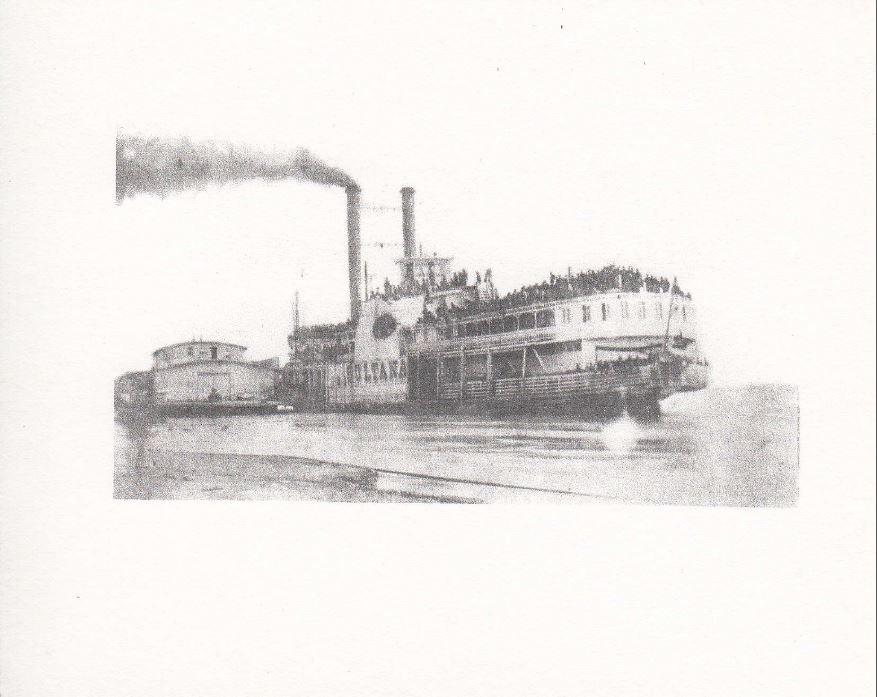 The Sultana Disaster Museum tells the story of the deadliest maritime disaster in United States history and is located at 104 Washington Street in Marion, Arkansas. It is a very nice museum, planning to grow into a larger space to better tell the story interactively and display more of their artifacts. A donation campaign is in its final stages for the larger space. Visit their website to learn more about the museum and the stories from the Sultana and the crew and passengers involved.
The Sultana Disaster Museum tells the story of the deadliest maritime disaster in United States history and is located at 104 Washington Street in Marion, Arkansas. It is a very nice museum, planning to grow into a larger space to better tell the story interactively and display more of their artifacts. A donation campaign is in its final stages for the larger space. Visit their website to learn more about the museum and the stories from the Sultana and the crew and passengers involved.
From the museum's website (www.sultanadisastermuseum.com):
The Worst Maritime Disaster in U.S. History
In the early morning hours of April 27, 1865, the steamboat Sultana exploded into a fiery blaze on the Mississippi River, eventually drifting and sinking near the Arkansas banks. At the Sultana Disaster Museum, we tell the lost stories of the disaster and those individuals who experienced it.
 The Sultana, a Civil War-era paddle-wheel steamboat, exploded and burned on the Mississippi River on April 27, 1865. Acknowledged by Congressional Resolution as the greatest maritime disaster in United States history, nearly 1,200 of the more than 2,200 passengers and crew were killed in the explosion and fire which sank the Sultana near Marion, Arkansas, across the river from Memphis, Tennessee. Designed to carry only 376 passengers plus crew, investigations revealed a litany of corrupt practices, including kickbacks, and bribes paid to high-ranking Union officers caused the overcrowding of the boat. The disaster has been overlooked in history since it was overshadowed by the assassination of President Abraham Lincoln and the search for his murderer. Events at the end of the Civil War conspired to wipe the memory of this tragic event from our national history for over 130 years. In its magnitude, the story of the Sultana is as great as that of the more famous Titanic, and yet much more intriguing.
The Sultana, a Civil War-era paddle-wheel steamboat, exploded and burned on the Mississippi River on April 27, 1865. Acknowledged by Congressional Resolution as the greatest maritime disaster in United States history, nearly 1,200 of the more than 2,200 passengers and crew were killed in the explosion and fire which sank the Sultana near Marion, Arkansas, across the river from Memphis, Tennessee. Designed to carry only 376 passengers plus crew, investigations revealed a litany of corrupt practices, including kickbacks, and bribes paid to high-ranking Union officers caused the overcrowding of the boat. The disaster has been overlooked in history since it was overshadowed by the assassination of President Abraham Lincoln and the search for his murderer. Events at the end of the Civil War conspired to wipe the memory of this tragic event from our national history for over 130 years. In its magnitude, the story of the Sultana is as great as that of the more famous Titanic, and yet much more intriguing.
 The Future Museum
The Future Museum
Recently, the Sultana Historic Preservation Society, Inc. acquired the 1939 Marion School Auditorium-Gymnasium for renovation as the future home of the permanent Sultana Disaster Museum. Utilizing the talents of Haizlip Studio of Memphis, TN, a team of architects, planners, and exhibit designers will work on state-of-the-art concepts to be presented in this 17,000 square foot facility. With a more accessible location, the historic building with ceilings nearing 35 feet offers ample capacity for a new, modern, high-tech museum, that will entertain and educate visitors of all ages. It also allows us to preserve and re-purpose one of the most historical buildings in eastern Arkansas. 
President's Letter, July 2020
- Details
July 1, 2020
Here I am in my library. Another month has flown (sure it has) by. I have a new highlight for my week: I now look forward to trash day. I make a bet with myself on whether or not they will pick it up this week, and I make a side bet with myself on what time they will pick it up. Yes, things are really raucous at the Calvert household. Because I am now tired of talking to my wife (This is just between you and me no one tells “she who must be obeyed” a thing.) I look forward to the unsolicited sales calls. I have found myself trying to have conversations and I am very disappointed when they hang up on me. What a world and what a time we live in.
Seriously, I have had a lot more time to read. I have gone back and read a few favorites and looked forward to having new books delivered. The old favorites are ones like Shiloh-in Hell before Night by James McDonough. The author tells the story of the battle from the participants” viewpoint. He still tries to debunk the old stories of: Was Grant surprised? Did the death of Johnston spell doom for the Confederates? Another favorite is Extreme Civil War, Guerilla Warfare, Environment, and Race on the Trans-Mississippi Frontier by Matthew Stith. The author writes about “the complex racial, environmental, and military dimensions that fueled brutal guerilla warfare” in the Trans-Mississippi theater of the Civil War. Stith brings a new understanding about why warfare in our area was so brutal.
Among the new books are The Union Assaults at Vicksburg, Grant Attacks Pemberton, May 17-22, 1863 by Timothy Smith. This subject seems to be rather focused. However, Smith provides a day by day and sometimes minute by minute account of Grant’s attempt to capture Vicksburg. This may be the first attempt to break down, into very understandable passages, the thoughts of the attacker and the attacked. Anyone interested in Vicksburg would do well to read this volume.
Next up is An Environmental History of the Civil War by Judkin Browning and Timothy Silver. A professor of military history and a student of environmental history come together to present that “the Civil War was not just a military conflict but also a moment of profound transformation in Americans’ relationship to the natural world.” Chapter titles include sickness, weather, food, animals, death and disability and terrain. The authors present a study of how these things affect the natural world then and now. I have never taken the time to think about it, but can you imagine what an army of 100,000 men, most of them with some sort of dysentery, would leave behind. Don’t even go there with the number of animals travelling with that army.
The last on my list and the one that just came today Commonwealth of Compromise, Civil War Commemoration in Missouri by Amy Laurel Fluker. Taken from the liner notes: “In the aftermath of the Civil War, white Unionists, African Americans, and former Confederates developed competing memories about its causes and consequences. In the border state of Missouri, debates about the war and its meaning proved particularly contentious.” I hope this book presented through the actual participants’ words will help me to understand a little bit about the world today. If I can understand the history, I hope I can have a better understanding of then and now.
Well, that’s what is on my book shelves. Keep reading. Keep striving to understand the past. Maybe just maybe we can begin to understand our today.
The Round Table board is working hard to start up our monthly meetings. Be assured that when it is safe and only when it is safe, we will meet. Stay safe and stay well. Miss you all.
Mike Calvert, President
Civil War Round Table of Western Missouri
An Historical Perspective -- We've Been Here Before
- Details
April 8, 2020
I was sitting in the library this evening and it dawned on me that I wasn’t where I supposed to be on the 2nd Wednesday of the month. I wasn’t with the group of people that I have shared the pursuit of knowledge with for 25 plus years. I wasn’t with you my friends and fellow history buffs. Each day seems to be much like another here on lock down. I watch or read the news, get upset, shout against what I have no control over and listen to Cindi say “If it upsets you that much, quit watching!” So I retreat to my sancta sanctorum to travel back in time to find an answer to what has turned the world upside down.
We have been here before and I don’t refer to the 1918 Flu Pandemic. I am referring to the Civil War. The first time our nation had to find an answer to a time of personal upheaval. The first time citizens had to confront masses of death, mass of sickness and masses of wounded. It wasn’t easy to find any solution. How to notify loved ones at home. How to understand that your soldier died alone. How to honor the dead. How to get an astronomical amount of needed medical supplies to the point of need. And to do this without a national or for that matter a local organization to provide the means. It was a steep learning curve. At the beginning of the war there wasn’t even a method to remove wounded from the battlefield to the hospital and most of the time even that hospital didn’t exist. The Army finally solved this, but the Army could never provide a solution for supplying the much needed material for healing.
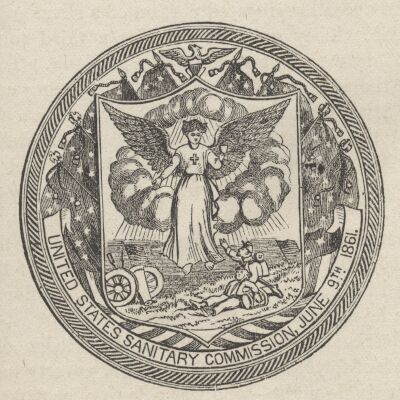 Out of this chaos The United States Sanitary Commission (USSC) was formed. A private relief agency created by federal legislation on June 18, 1861, to support sick and wounded soldiers of the United States Federal Army. It operated across the North, raised an estimated $25 million in Civil War era revenue (assuming 1865 dollars, $417.55 million in 2020) and in-kind contributions to support the cause, and enlisted thousands of volunteers. The president was Henry Whitney Bellows, and Frederick Law Olmsted acted as executive secretary. The power of the American people in a most grass roots sense.
Out of this chaos The United States Sanitary Commission (USSC) was formed. A private relief agency created by federal legislation on June 18, 1861, to support sick and wounded soldiers of the United States Federal Army. It operated across the North, raised an estimated $25 million in Civil War era revenue (assuming 1865 dollars, $417.55 million in 2020) and in-kind contributions to support the cause, and enlisted thousands of volunteers. The president was Henry Whitney Bellows, and Frederick Law Olmsted acted as executive secretary. The power of the American people in a most grass roots sense.
We don’t have a Sanitary Commission. We do have a nation of people that when, a need is known they come together for a solution. We see it every day from the individuals that sew masks, to the food pantries and to the people that make sure that no one is forgotten. We all do our part every day by staying at home or if you must go out staying apart. Did you ever think that we would come together for a common cause by staying apart? We have been through this before. It is not easy. It never has been. Stay home. Stay safe and we will see each other before long. Oh, the stories we will tell.
-- Mike Calvert, President of the Civil War Round Table of Western Missouri
[Photo credit -- True Williams (1839-1897) - Gutemberg.org, Public Domain, https://commons.wikimedia.org/w/index.php?curid=6987745]
Start planning your Wargasm
- Details
May 1, 2020
Again, I find myself in my library looking out the backdoor and watching anything that might be happening just to break the monotony. I started to count the birds and then squirrels. After that was complete, I started separating them by color and size. I need help. I have been on lock down since March 12. I am getting just a little bit stir crazy. Since I cannot go anywhere at this time (by the way I fully support this), I have started to plan future trips. You might remember that I refer to these Civil War related trips as Wargasms. I didn’t invent this phrase; Tony Horowitz introduced me to it in his book Confederates in the Attic.
For my next Wargasm I have started plans to visit Vicksburg and the sites of the supporting battles. When I go to a battlefield, I like to travel the routes the armies took. As best a possible anyway. I have been able to follow Lee/Meade into Gettysburg, Lee/McClellan into Antietam, Jackson up and down the valley, Early to Monacacy, Rosecrans’ retreat to Chattanooga from Chickamauga and Sherman’s march to Atlanta and the sea. By taking Longstreet’s march on Little Round Top, you discover, even today, that if he continued on his original route he would have been exposed to the Federal troops and any surprise would be gone. By the way, locally if you want to know why the battles of Price's Raid in the Kansas City area were fought where they were, don’t follow the troops -- follow the wagon train. I like to do the research to find these routes and by taking these routes develop an understanding of why a battle was fought where it was. Needless to say, planning for these trips takes some time. The experience at the battlefield is enriched with a little background study. Knowing where, what, when and how will enrich the experience of your battlefield excursion. So, take some time (you have plenty of time right now) and start planning your Wargasm.
Just because the tour brochure says your battlefield exploration will take 3 hours, it doesn’t mean you can’t take 3 days or more. Good luck, good travels and stay safe. We will be able to travel together again before we know it.
PS: If you ever begin to question why you have been in your house for weeks on end, read this.
'No Man is an Island'
No man is an island entire of itself; every man
is a piece of the continent, a part of the main;
if a clod be washed away by the sea, Europe
is the less, as well as if a promontory were, as
well as any manner of thy friends or of thine
own were; any man's death diminishes me,
because I am involved in mankind.
And therefore never send to know for whom
the bell tolls; it tolls for thee.
MEDITATION XVII
Devotions upon Emergent Occasions
John Donne 1624
-- Mike Calvert, President of the Civil War Round Table of Western Missouri
"Quantrill’s Revenge: A Comprehensive Tour Guide to William C. Quantrill’s Raid of Lawrence, Kansas"
- Details
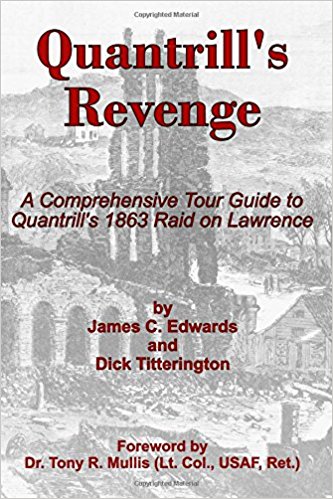 Authors: James C. Edwards and Dick Titterington
Authors: James C. Edwards and Dick Titterington
Forward: Dr. Tony R. Mullis
In August 1863, guerrilla chieftain William C. Quantrill led around 400 Missouri guerrillas deep into Kansas to attack Lawrence, “the great hot-bed of abolitionism in Kansas.” Over a four-day period, Quantrill led his men over 90 miles from Johnson County, Missouri, to Lawrence where they burned much of the town and killed over 150 townsmen. After spending 4 hours in Lawrence, Quantrill took an 80 mile route back into Missouri, skirmishing with Union cavalry along the way. This tour guide contains 49 tour stops and follows the route taken by Quantrill’s guerrillas during their 1863 raid on Lawrence, Kansas. The tour begins in Johnson County, Missouri and goes west through Jackson and Cass Counties, Missouri, to the Kansas state line. The tour enters Kansas just north of the boundary between Johnson and Miami Counties, Kansas, and continues heading northwest through Johnson and Douglas Counties, Kansas, on the way to Lawrence. As you might expect, most of the tour stops are located in Lawrence, Kansas. After Lawrence there are a number of tour stops following the route taken by Quantrill’s guerrillas on their way back to Missouri as they were pursued by Federal troops. Altogether the tour covers a distance of approximately 175 miles from start to finish.
List price: $24.99 on Amazon
 Click the AmazonSmile logo to the right to purchase it through AmazonSmile (be sure to sign into AmazonSmile) and have your order routed through the philanthropic arm of Amazon. The Civil War Round Table of Western Missouri is a duly registered not-for-profit which can receive a small remittance for your order.
Click the AmazonSmile logo to the right to purchase it through AmazonSmile (be sure to sign into AmazonSmile) and have your order routed through the philanthropic arm of Amazon. The Civil War Round Table of Western Missouri is a duly registered not-for-profit which can receive a small remittance for your order.



